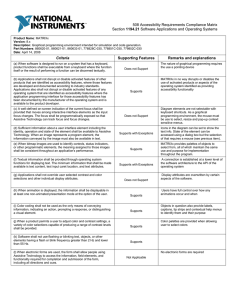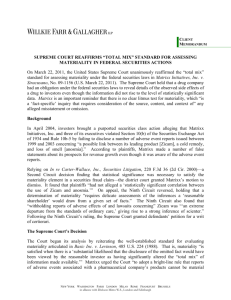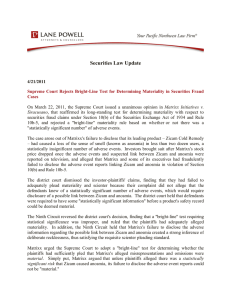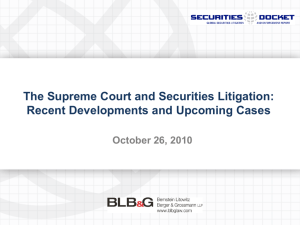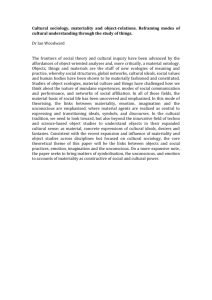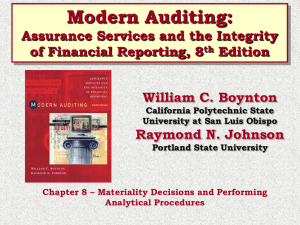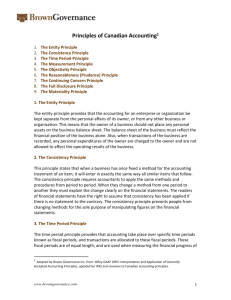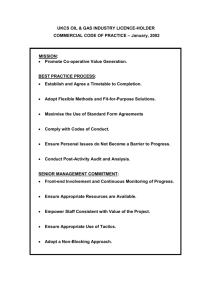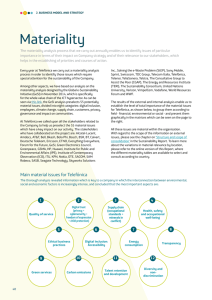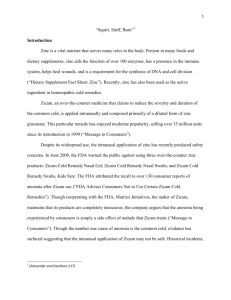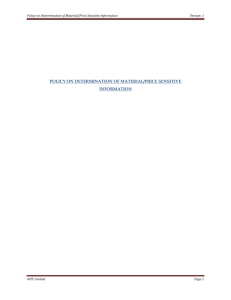Down the Rabbit Hole with the US Supreme Court
advertisement
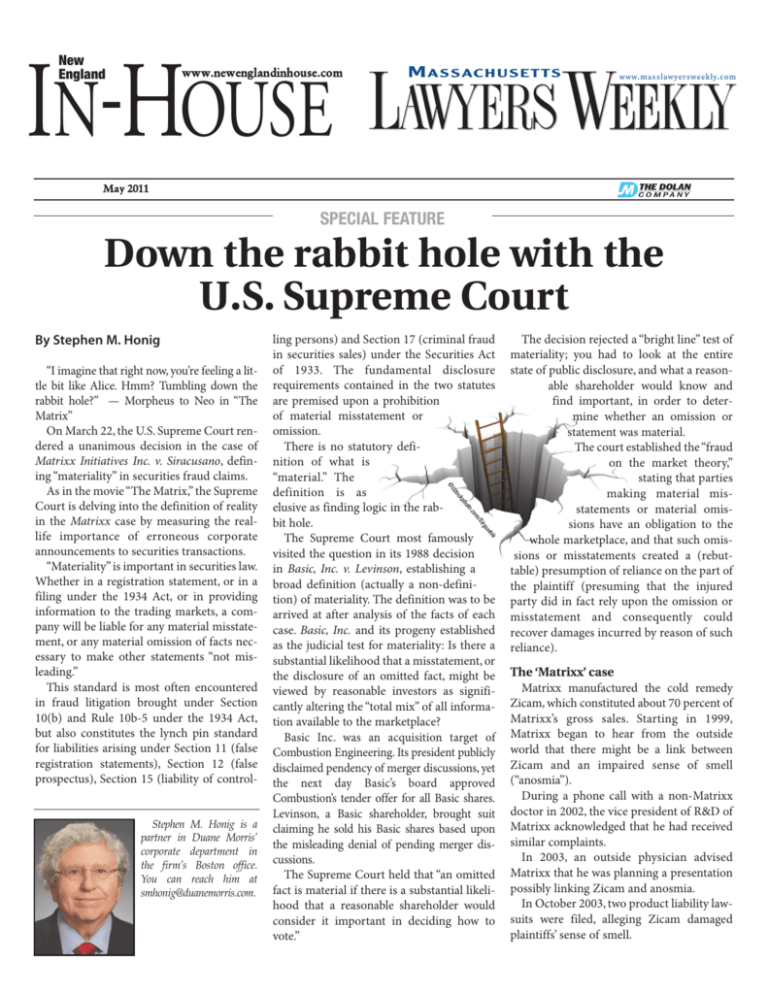
New England IN-HOUSE www.newenglandinhouse.com M A S S AC H U S E T T S www.masslawyersweekly.com May 2011 Special feature Down the rabbit hole with the U.S. Supreme Court By Stephen M. Honig hik un irg /S Stephen M. Honig is a partner in Duane Morris’ corporate department in the firm’s Boston office. You can reach him at smhonig@duanemorris.com. m co to. ho kp oc iSt © “I imagine that right now, you’re feeling a little bit like Alice. Hmm? Tumbling down the rabbit hole?” — Morpheus to Neo in “The Matrix” On March 22, the U.S. Supreme Court rendered a unanimous decision in the case of Matrixx Initiatives Inc. v. Siracusano, defining “materiality” in securities fraud claims. As in the movie “The Matrix,” the Supreme Court is delving into the definition of reality in the Matrixx case by measuring the reallife importance of erroneous corporate announcements to securities transactions. “Materiality” is important in securities law. Whether in a registration statement, or in a filing under the 1934 Act, or in providing information to the trading markets, a company will be liable for any material misstatement, or any material omission of facts necessary to make other statements “not misleading.” This standard is most often encountered in fraud litigation brought under Section 10(b) and Rule 10b-5 under the 1934 Act, but also constitutes the lynch pin standard for liabilities arising under Section 11 (false registration statements), Section 12 (false prospectus), Section 15 (liability of control- ling persons) and Section 17 (criminal fraud in securities sales) under the Securities Act of 1933. The fundamental disclosure requirements contained in the two statutes are premised upon a prohibition of material misstatement or omission. There is no statutory definition of what is “material.” The definition is as elusive as finding logic in the rabbit hole. The Supreme Court most famously visited the question in its 1988 decision in Basic, Inc. v. Levinson, establishing a broad definition (actually a non-definition) of materiality. The definition was to be arrived at after analysis of the facts of each case. Basic, Inc. and its progeny established as the judicial test for materiality: Is there a substantial likelihood that a misstatement, or the disclosure of an omitted fact, might be viewed by reasonable investors as significantly altering the “total mix” of all information available to the marketplace? Basic Inc. was an acquisition target of Combustion Engineering. Its president publicly disclaimed pendency of merger discussions, yet the next day Basic’s board approved Combustion’s tender offer for all Basic shares. Levinson, a Basic shareholder, brought suit claiming he sold his Basic shares based upon the misleading denial of pending merger discussions. The Supreme Court held that “an omitted fact is material if there is a substantial likelihood that a reasonable shareholder would consider it important in deciding how to vote.” The decision rejected a “bright line” test of materiality; you had to look at the entire state of public disclosure, and what a reasonable shareholder would know and find important, in order to determine whether an omission or statement was material. The court established the “fraud on the market theory,” stating that parties making material misstatements or material omissions have an obligation to the whole marketplace, and that such omissions or misstatements created a (rebuttable) presumption of reliance on the part of the plaintiff (presuming that the injured party did in fact rely upon the omission or misstatement and consequently could recover damages incurred by reason of such reliance). The ‘Matrixx’ case Matrixx manufactured the cold remedy Zicam, which constituted about 70 percent of Matrixx’s gross sales. Starting in 1999, Matrixx began to hear from the outside world that there might be a link between Zicam and an impaired sense of smell (“anosmia”). During a phone call with a non-Matrixx doctor in 2002, the vice president of R&D of Matrixx acknowledged that he had received similar complaints. In 2003, an outside physician advised Matrixx that he was planning a presentation possibly linking Zicam and anosmia. In October 2003, two product liability lawsuits were filed, alleging Zicam damaged plaintiffs’ sense of smell. 2 • NEW ENGLAND IN-HOUSE Notwithstanding the foregoing, on Oct. 22, 2003, Matrixx issued an optimistic press release stating that the company was “poised for growth” and that revenues would be up “in excess of 50 percent.” The plaintiff, who purchased Matrixx securities based upon information in the marketplace, brought a class action for his losses, and for losses incurred by persons similarly situated, during the time period beginning with this optimistic press release. In November 2003, the Matrixx 10-Q included a generic risk factor concerning product liability, without mentioning the litigation or acknowledging prior claims. In early 2004, Matrixx further raised its revenue projections. Later in January, the Dow Jones newswire reported that the FDA was looking into complaints that a Matrixx cold medicine might be linked to anosmia and, several days later, Matrixx issued a positive press release in response, causing company stock to rebound to its prior level. This press release stated that Zicam’s relationship to anosmia is “completely unfounded and misleading,” notwithstanding that Matrixx was alleged to have done no clinical research and notwithstanding its knowledge of various claims, including the lawsuits themselves. The release further stated that no link was found in clinical trials, that adverse events associated with the product were “extremely low,” and that loss of smell can be caused by a multitude of environmental and biologic influences, including the common colds that the product was designed to combat. On Feb. 4, 2004, the television program “Good Morning America” announced scientific findings linking Zicam with anosmia, noting that more than a dozen cases were reported and four lawsuits had been filed. Matrixx nonetheless filed a Form 8-K on Feb. 19 stating that it was investigating these accusations but that there was “insufficient scientific evidence at this time” to ascribe linkage. March 2011 In U.S. District Court, Matrixx moved to dismiss the class action for failure properly to plead that any misstatement or omission was “material” and failure to plead requisite scienter (intent to deceive). The court threw out the suit, but the 9th Circuit reversed, applying the Basic standard for materiality. The Supreme Court accepted certiorari in the case, presumably because of a conflict between the 9th Circuit opinion and caselaw from the 2nd Circuit. The court applied Basic’s “total mix” standard and refused to develop a bright-line rule requiring that “statistically significant data” must be shown to establish materiality. Such a rigid rule would exclude from evidence information that “would otherwise be considered significant to the trading decision of a reasonable investor.” The court stated that medical experts and the FDA often consider a variety of factors in assessing causation and don’t require that these factors rise to a level of “statistical significance.” The key test is whether the evidence is suggestive, not categorical, proof. The court noted that in 2009 the FDA issued a warning to Matrixx concerning possible health risks of its drug that cited various reports of anosmia and suggestive scientific literature, none of which rose to a level of “statistical significance.” If medical experts and the FDA infer possible causation from such data, a reasonable investor might well reach the same conclusion. Additionally, medical researchers reach conclusions in cases in which statistically significant data is not always available. The SEC filed an amicus brief supportive of the 9th Circuit. The court also relied upon an amicus brief filed by a group of law professors, stating that the law concerning materiality as articulated in Basic had proven to be an effective standard in litigation since 1988. The holding in Matrixx does not mean that reports of adverse events necessarily mandate disclosure. Companies have to con- sider the context, content and source of the reports. But a plaintiff does not have to produce “statistically significant evidence” to prove the necessary 10b-5 element of scienter; pleaded facts may give a strong inference of an intent to deceive, defraud or manipulate even absent specific showing of statistical significance. How to proceed While some commentators have suggested that the Matrixx case should be interpreted as the “law of materiality” only with respect to FDA-related cases, this is too narrow a reading. The opinion is clear and is not so limited on its face. The reinforcement of the Basic decision, which had nothing to do with the life sciences, is further indication of the generality of the rule. In light of Basic’s “fraud on the market” approach, public companies should: • Carefully evaluate, to the extent possible in an arm’s length way, the impact that particular facts might have on an investor, viewing the pre-existing disclosures in the marketplace as a pre-condition for that evaluation; • Monitor statements made not only in press releases and SEC filings but also by officers, directors and representatives that may affect the totality of the information in the marketplace and consequently impact materiality; • Recognize that subtle information may be material, even if speculative and unproven. Indeed, the Matrixx argument that statistical significance must be demonstrated clearly is not the law; a unique event may have no statistical antecedent and yet be clearly material. For example, there were no prior earthquake-induced meltdowns of Japanese nuclear facilities and thus no statistically significant background, but no sane person would question materiality. NEIH Reprinted with permission from The Dolan Co., 10 Milk Street, Boston, MA 02108. (800) 444-5297 © 2011 #01443vw
